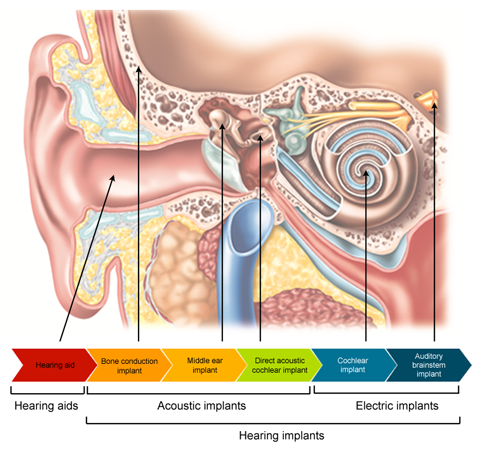Solution for all hearing problems
Hearing problems have been associated with poor quality of life, cognitive decline and an important source of frustration. In 2012, the World Health Organization (WHO) released new estimates on the magnitude of disabling hearing loss: over 5% of the world’s population, 360 million people, has disabling hearing loss, ranking it as a top priority in health care. Their number increases because of an aging population and a raised awareness of hearing with two ears, certainly for communication.
In Leuven, a full coverage of hearing rehabilitation ranging from hearing aids over acoustic hearing implants to cochlear implants is currently provided to the patients. Already in 1993, the University Hospitals Leuven have successfully started a cochlear implant programme; implanting multichannel electrical cochlear implants both in young children and in adults. Since then, a rapidly growing number of people has received a cochlear implant, offering a detailed representation of sounds for the hard-of-hearing and the deaf.

The approach to hearing loss and hearing implant’s implantation of the University Hospitals Leuven includes both pre- and postoperative speech and language evaluation, along with educational recommendations and support for children and adults. It focuses on individual care of the patient and his hearing loss. The skilled hearing implant team offers a comprehensive approach based on the current clinical standards with an open window towards innovative translational research.
A bridge between science and health care
The clinical use of hearing implants and the research providing real-time feedback of the implant’s functioning during surgery embodies just one of the many ongoing projects between the department of Otorhinolaryngology, head and neck surgery of the University Hospitals Leuven and the research group ExpORL of the KU Leuven.
This unique cooperation, often in collaboration with the hearing industry and with support of European, Belgian and Flemish research funding, has resulted in many innovative achievements.
Future
Further research with a focus on automated fitting, sound localization, learning and brain processes with hearing (mainly cochlear) implants is currently ongoing. Also, more insights in the vibromechanical functionning of the inner ear is needed.
By achieving new knowledge and insights about hearing, our future patients will be helped, achieving a faster and more individualised hearing treatment.
About Leuven hearing implant hub
In harmony with the strong clinical University Hospitals Leuven department which focuses on health care, the KU Leuven research unit ExpORL aims to unravel the human auditory processing and the use of hearing implants. Over the past decades, our research unit, currently with more than 25 researchers, has built an important scientific network in collaboration with the KU Leuven departments of electrical engineering and orthopedagogics, with the lab of auditory neurophysiology, with hearing industrial partners, with national and international academic research partners and many more.
The search for new insights and developments on a broad spectrum of auditory topics has resulted in a globally renowned research institution in the field of hearing and hearing prosthesis, named the Leuven hearing implant hub.
- Research group Experimental Oto-rhino-laryngology (ExpORL)
Is part of the KU Leuven department of Neurosciences and conducts extensive, fundamental, clinical and translational research into ‘human auditory processing and prosthesis’ and in ‘speech, language and swallowing disorders’. - Department of Otorhinolaryngology, Head and Neck surgery of the University Hospitals Leuven
Offers comprehensive evaluation and treatment for patients with ear and hearing disorders, both for children and adults.
Example: DACI, new type of hearing implants
An example of individual health care is provided in what follows: a growing subgroup of hearing-impaired subjects is confronted with an important mixed hearing loss (a combination of sound transfer problem due to middle and inner ear problems).
Conventional hearing aids will not help these patients. In recent years, new implants which drive the inner ear through mechanical (different to electrical cochlear implants) vibrations have been developed. These are defined as acoustic hearing implants.
First in Belgium
A new technique, implanting a direct acoustic cochlear implant or DACI, has very recently been introduced in the University Hospitals Leuven, making it the first centre in Belgium to perform this and the fourth worldwide.
By attaching the implant directly to the inner ear’s fluid in the cochlea, many patients can be helped. The technique offers an alternative to hearing aids or even cochlear implants in selected patients, involving different advantages:
Amplification of sounds
A sound is a vibration that propagates as a mechanical wave of pressure and displacement. Typically, these patients have a lack of amplication because of a fixed or absent ossicular chain in the middle ear.
The DACI speech processor picks up the sound and amplifies it. Then, the electromagnetical driver will bring the amplified signal to the inner ear's fluid.
Natural sound
The implant stimulates the inner ear acoustically. This way the sensory cells are retained which means that the patient will be able to hear with his own inner ear.
This results in a more natural sound, as opposed to the ‘electrical hearing’ of a classic 'electrical' cochlear implant.